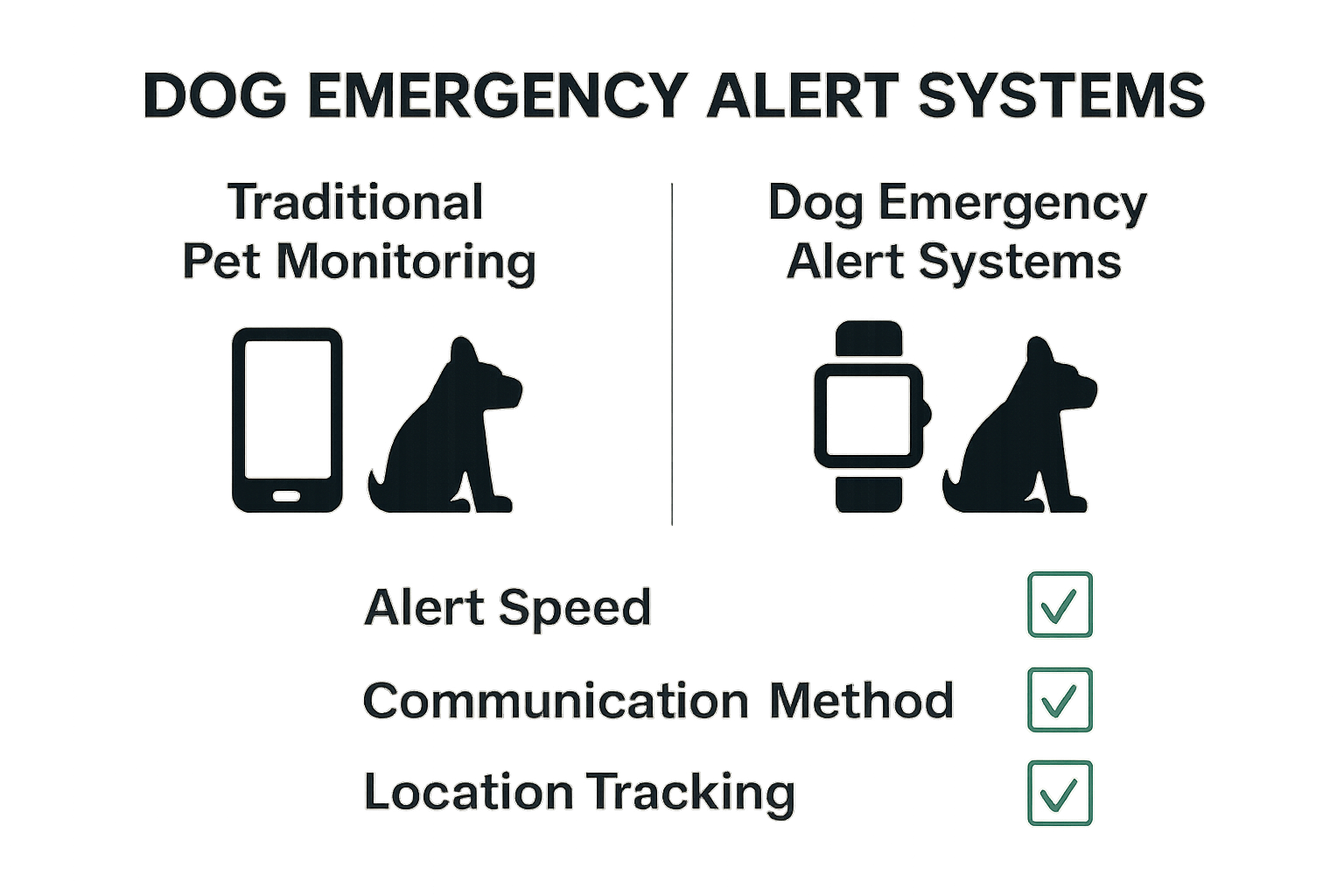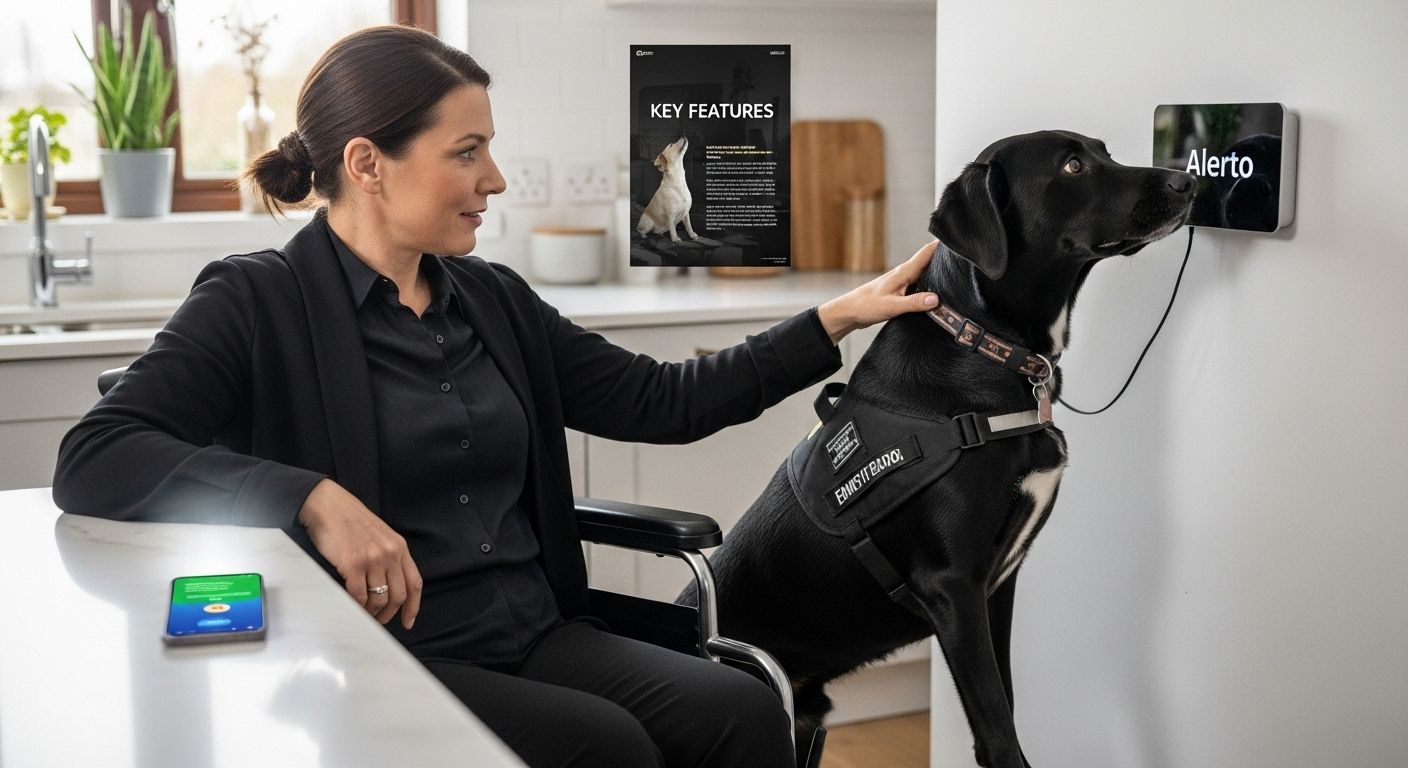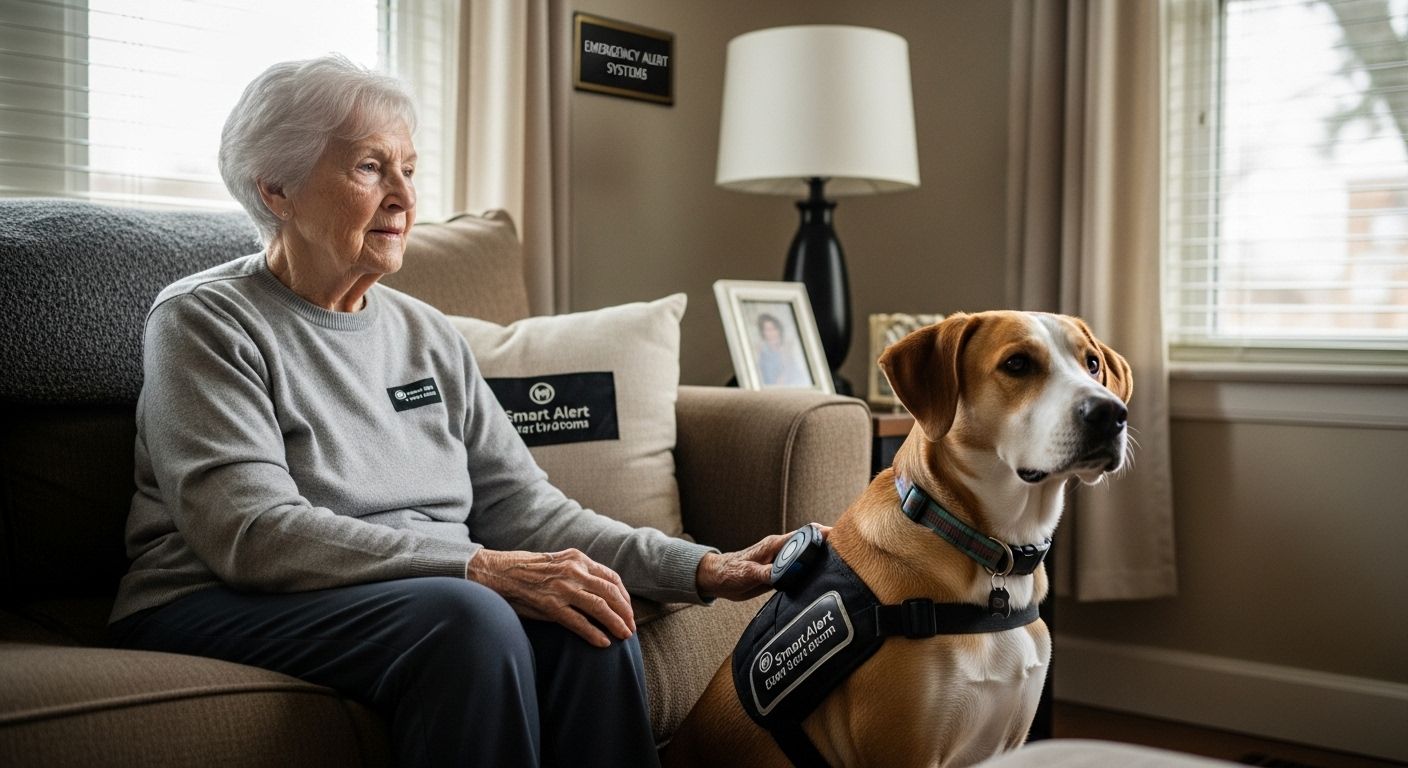Dog emergency alert systems sound futuristic, but their impact is already real and surprising. Most people think dogs can only bark or scratch at the door when something is wrong. Yet, intelligent sensor networks inside these systems can actually recognize specific canine behavior and send instant emergency notifications. That means technology is now giving dogs the power to call for help when it matters most.
Table of Contents
- What Are Dog Emergency Alert Systems?
- Why Dog Emergency Alert Systems Matter for Pet Owners
- How Dog Emergency Alert Systems Function
- Key Features and Technologies of Dog Emergency Alert Systems
Quick Summary
| Takeaway | Explanation |
|---|---|
| Dog alert systems enhance communication. | These systems allow dogs to signal distress and emergencies effectively, improving safety. |
| They cater to vulnerable pet populations. | Service dogs, elderly pets, and those with medical conditions benefit significantly from these technologies. |
| Features ensure reliable emergency responses. | Modern systems employ sensors and wireless technology to provide instant alerts and location tracking. |
| Advanced algorithms decode canine signals. | These systems use sophisticated algorithms to interpret dog behaviors into actionable notifications during emergencies. |
| Create peace of mind for pet owners. | By leveraging these systems, pet owners can ensure rapid communication and support in critical situations. |
What Are Dog Emergency Alert Systems?
Dog emergency alert systems represent an innovative technological solution designed to enhance communication and safety for dogs and their handlers. These sophisticated devices enable dogs to communicate critical information during emergencies, providing a vital lifeline for individuals with disabilities, seniors living alone, and service dog handlers.
The Core Purpose of Emergency Alert Systems
At their fundamental level, dog emergency alert systems are communication tools that allow canines to signal distress, medical emergencies, or urgent situations. Unlike traditional communication methods, these systems provide a direct, immediate channel for dogs to communicate with humans when verbal communication is impossible.
Key functions of these systems typically include:
- Triggering immediate alerts during medical emergencies
- Signaling potential dangers or threats
- Providing location tracking for service and assistance dogs
- Enabling remote monitoring for pet owners
How Dog Emergency Alert Systems Work
Modern dog emergency alert systems leverage advanced technologies like wireless communication, sensor networks, and specialized hardware to create a seamless communication pathway. Research from the International Conference on Animal-Computer Interaction highlights how these systems can recognize specific canine behavioral patterns and translate them into actionable emergency signals.
Typical mechanisms include wearable devices with programmable buttons, motion sensors, and connectivity features that can send instant notifications to designated emergency contacts or smartphone applications. For service dogs and assistance animals, these systems represent more than a technological innovation they are a critical tool for independence and safety.
Learn more about advanced dog alert technologies that are transforming how we understand and support our canine companions in emergency situations.
Why Dog Emergency Alert Systems Matter for Pet Owners
Pet owners face numerous challenges when ensuring their dogs’ safety, especially during unexpected emergencies. Dog emergency alert systems have emerged as a critical technological solution that addresses these complex safety concerns, providing peace of mind and potentially life-saving communication capabilities.
Protecting Vulnerable Pet Populations
Certain dog populations are particularly vulnerable and require specialized emergency support. Service dogs, elderly pets, dogs with medical conditions, and animals living with individuals with disabilities benefit significantly from emergency alert technologies. These systems create an essential communication bridge that traditional methods cannot provide.
Key vulnerable populations include:
- Senior dogs with limited mobility
- Dogs assisting individuals with disabilities
- Pets with chronic health conditions
- Working dogs in high-risk environments
To help readers understand which canine populations benefit the most from dog emergency alert systems, the following table summarizes key vulnerable groups and the specific support these systems offer.
| Vulnerable Dog Population | How Alert Systems Provide Support |
|---|---|
| Senior dogs with limited mobility | Enables emergency alerts in case of falls or health incidents |
| Dogs assisting individuals with disabilities | Facilitates communication when handlers are unable to respond verbally |
| Pets with chronic health conditions | Quickly alerts owners during medical events |
| Working dogs in high-risk environments | Sends instant notifications if the dog detects danger or distress |
Critical Safety and Communication Benefits
Research from the Federal Emergency Management Agency underscores the importance of comprehensive emergency preparedness for pets. Dog emergency alert systems offer multiple critical safety advantages:
- Immediate notification during medical emergencies
- Location tracking for lost or wandering pets
- Remote monitoring capabilities
- Rapid communication of distress signals
Beyond immediate emergency response, these systems represent a profound technological advancement in human-animal communication. They transform how pet owners understand and respond to their dogs’ needs, creating a more connected and responsive relationship.
Explore advanced pet safety technologies that are revolutionizing pet care and emergency preparedness. These innovative solutions are not just technological tools but lifelines that protect our most cherished companions.
How Dog Emergency Alert Systems Function
Dog emergency alert systems represent a sophisticated fusion of technology and canine behavior, designed to create a seamless communication pathway between dogs and their handlers. These advanced systems leverage multiple technological components to ensure reliable and instantaneous emergency communication.
Core Technological Components
The fundamental architecture of dog emergency alert systems involves several interconnected technological elements that work in harmony to detect, process, and transmit critical information. Sensor networks and wireless communication form the backbone of these innovative systems, enabling real-time monitoring and instant alert generation.
Key technological components include:
- Wearable devices with integrated sensors
- Wireless communication modules
- GPS tracking capabilities
- Programmable alert buttons
- Smartphone connectivity interfaces
To clarify the essential technological components that form the foundation of dog emergency alert systems, the following table breaks down each major element and its primary function.
| Technological Component | Function |
|---|---|
| Wearable devices with integrated sensors | Detects canine movement and vital signs |
| Wireless communication modules | Transmits alerts to owners or emergency contacts |
| GPS tracking capabilities | Provides real-time location information |
| Programmable alert buttons | Allows dogs to send manual distress signals |
| Smartphone connectivity interfaces | Enables remote monitoring and notification |
Signal Detection and Communication Mechanisms
Research from the International Conference on Animal-Computer Interaction reveals the intricate process of translating canine behavioral signals into actionable emergency notifications. These systems utilize advanced algorithms that can recognize specific movement patterns, physiological changes, and behavioral cues that indicate potential emergencies.
The communication process typically follows these stages:
- Initial signal detection through integrated sensors
- Algorithm-based emergency verification
- Instant notification transmission
- Routing alerts to designated emergency contacts
Precise signal interpretation distinguishes these systems from traditional monitoring technologies. By understanding nuanced canine communication signals, these alert systems provide a revolutionary approach to pet safety and emergency response.
Discover the latest innovations in canine alert technologies that are transforming how we understand and respond to our dogs’ emergency needs.
Key Features and Technologies of Dog Emergency Alert Systems
Dog emergency alert systems incorporate advanced technological features that transform how we understand and respond to canine communication. These sophisticated systems blend cutting-edge hardware, intelligent software, and intuitive design to create comprehensive safety solutions for dogs and their handlers.


Advanced Sensing and Detection Technologies
Intelligent sensor networks represent the cornerstone of modern dog emergency alert systems. These technological frameworks go beyond simple motion detection, utilizing complex algorithms to interpret nuanced canine behavioral signals and physiological changes.
Key sensing technologies include:
- Accelerometer-based movement tracking
- Heart rate and respiratory monitoring sensors
- Temperature variation detection mechanisms
- Pressure-sensitive input triggers
- Geolocation and boundary mapping capabilities
Communication and Connectivity Frameworks
Research from the Emergency Management Response System highlights the critical importance of seamless communication infrastructure in emergency alert technologies. Modern dog emergency alert systems leverage multiple communication channels to ensure rapid, reliable information transmission.
Communication features encompass:
- Wireless cellular network connectivity
- Bluetooth and low-energy transmission protocols
- Cloud-based data synchronization
- Multi-device alert routing
- Secure encrypted communication channels
Real-time data processing distinguishes contemporary dog emergency alert systems from earlier generations. By integrating advanced machine learning algorithms, these systems can distinguish between routine behaviors and genuine emergency signals with remarkable precision.
Explore cutting-edge alert system innovations that are revolutionizing pet safety and communication technologies.
Ready to Give Your Dog a Real Voice in Emergencies?
You have just learned how today’s dog emergency alert systems offer vital communication and safety benefits. Whether you need instant alerts in a crisis, dependable location tracking, or a true lifeline for service dogs or seniors living alone, the challenge is always the same. How do you break the barrier between what your dog feels and what you know in those critical moments? With the right technology and support, you do not have to face those anxieties alone. Instead, empower your dog and yourself with proven solutions that are already changing lives.

Now is the time to explore how the iPupPee device turns everything covered in this guide into real peace of mind. Its simple button press system, backed by expert training resources, helps dogs communicate emergencies quickly and clearly. Browse product information and benefits or dive into our blog for training tips and owner stories. Choose safety, confidence, and a deeper connection with your dog. Visit ipuppee.com today to take control of your dog’s emergency readiness.
Frequently Asked Questions
What are dog emergency alert systems?
Dog emergency alert systems are technological devices that enable dogs to communicate critical information to their handlers during emergencies, helping to ensure the safety of both the dog and its owner.
How do dog emergency alert systems work?
These systems use advanced technologies such as wireless communication, sensors, and specialized hardware to detect canine behaviors and translate them into emergency alerts, enabling rapid communication when verbal signals are not possible.
What features should I look for in a dog emergency alert system?
Key features to consider include wearable devices with integrated sensors, GPS tracking, programmable alert buttons, wireless connectivity, and real-time data processing capabilities to effectively respond to your dog’s needs during an emergency.
Who can benefit from dog emergency alert systems?
Vulnerable pet populations, including senior dogs, service dogs, dogs with chronic health conditions, and pets living with individuals with disabilities, greatly benefit from these systems, offering critical communication and support in emergencies.
Recommended
-
[
Dog Alert Systems Explained: A 2025 Guide for Owners and Handlers
– iPupPee](https://ipuppee.com/blogs/news/dog-alert-systems-explained-2025-guide)
-
[
Best Dog Alert Options for Owners and Handlers in 2025
– iPupPee](https://ipuppee.com/blogs/news/dog-alert-options-guide-2025)
-
[
Dog Alert Signals: Recognize and Respond for Safety in 2025
– iPupPee](https://ipuppee.com/blogs/news/dog-alert-signals-recognize-respond-2025)
-
[
Dog Alert Device Training Guide for 2025: Easy Steps & Tips
– iPupPee](https://ipuppee.com/blogs/news/dog-alert-device-training-guide-2025)

